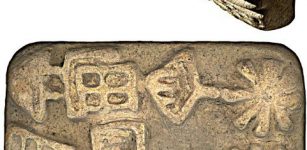The Untold Story Of The Great Sphinx – One Of The Greatest – Part 1
Ellen Lloyd - AncientPages.com - His nose is broken, and his eyes are nothing but holes. His head is still bearing some traces of red and yellow paint, has been badly battered.
He was buried several times by the desert sand, and he has suffered severe erosion.
Yet, he has rested for thousands of years on the Giza plateau at the west bank of the Nile River.
In silence, he has kept a watching eye on the ancient and modern world. He stands almost forgotten in the shadow of the pyramids, but he is and always has been one of the greatest. The Great Sphinx of Egypt is an icon of the ancient Egyptian civilization.
To the Egyptians the Sphinx was the symbol of strength and intelligence. It represents an aspect of the sun god, Re-Horakhte, sometimes called Hor-m-akhet, or Harmachis.
The origin of the term "sphinx" is unknown, but it is possible that it is derived from the Egyptian words "shesep ankh", meaning "living image".
Cut out from a natural outcrop of limestone, the Sphinx is one of the largest surviving statues from the ancient world, but what or whom does the Sphinx represent?
We will now begin a long journey to the land of the Pyramids and investigate the untold story of the Sphinx.
This is a preview of our premium article available only to members of Ancient Pages.
Become a member to read more - Click here
If you are already a member and have logged in to your account, you can access the article here
See also:
Antediluvian Time-Capsule Hidden In Forbidden Ancient Egyptian Crypts?
Was Ancient Egyptian Science Inherited From A Lost Atlantean Civilization?
More From Ancient Pages
-
 Incest In The Elite Of Neolithic Ireland – Incredible Findings
Archaeology | Jun 24, 2020
Incest In The Elite Of Neolithic Ireland – Incredible Findings
Archaeology | Jun 24, 2020 -
 Rare 3,000-Year-Old Jerubbaal Inscription Of Biblical Judge Discovered In Israel
Archaeology | Jul 14, 2021
Rare 3,000-Year-Old Jerubbaal Inscription Of Biblical Judge Discovered In Israel
Archaeology | Jul 14, 2021 -
 Ancient Secrets Of The Masters Of Mu – Myths And Legends Examined – Part 1
Ancient Mysteries | Aug 24, 2018
Ancient Secrets Of The Masters Of Mu – Myths And Legends Examined – Part 1
Ancient Mysteries | Aug 24, 2018 -
 Centuries Old Pub Discovered In Dover, England
Archaeology | Oct 28, 2024
Centuries Old Pub Discovered In Dover, England
Archaeology | Oct 28, 2024 -
 Mysterious Mummified Woman With A Christian Cross On Her Chest Dashes Hopes Of Finding First Russian Fortress In Yakutia
Archaeology | Dec 12, 2019
Mysterious Mummified Woman With A Christian Cross On Her Chest Dashes Hopes Of Finding First Russian Fortress In Yakutia
Archaeology | Dec 12, 2019 -
 120-Million-Year-Old Fossil Reveals Early Bird’s Leaf-Eating Habits
Fossils | Aug 8, 2023
120-Million-Year-Old Fossil Reveals Early Bird’s Leaf-Eating Habits
Fossils | Aug 8, 2023 -
 El Gigante Offers Lessons In Sustainability, Evolution And Human Adaptation, Courtesy Of The Holocene
Archaeology | Jun 29, 2023
El Gigante Offers Lessons In Sustainability, Evolution And Human Adaptation, Courtesy Of The Holocene
Archaeology | Jun 29, 2023 -
 Early, Complex Brain Surgery Performed In Ancient Greece
Archaeology | Apr 8, 2020
Early, Complex Brain Surgery Performed In Ancient Greece
Archaeology | Apr 8, 2020 -
 Oldest Human Made Architectural Plans Detail Mysterious Desert Megastructures
Archaeology | May 18, 2023
Oldest Human Made Architectural Plans Detail Mysterious Desert Megastructures
Archaeology | May 18, 2023 -
 Mystery Of Paracelsus’s Magical Sword Azoth – Rumors Or Truth?
Featured Stories | Jun 17, 2025
Mystery Of Paracelsus’s Magical Sword Azoth – Rumors Or Truth?
Featured Stories | Jun 17, 2025 -
 How And Why Did Ancient Egyptians Women’s Rights Change During The Greco-Roman Period?
Archaeology | Apr 16, 2019
How And Why Did Ancient Egyptians Women’s Rights Change During The Greco-Roman Period?
Archaeology | Apr 16, 2019 -
 Fashion Police Enforced Gender Norms In Early Modern Genoa
Social Sciences | Dec 11, 2024
Fashion Police Enforced Gender Norms In Early Modern Genoa
Social Sciences | Dec 11, 2024 -
 Florida’s Ancient Underwater Burial Site Much Older Than Previously Thought
Archaeology | Jun 24, 2019
Florida’s Ancient Underwater Burial Site Much Older Than Previously Thought
Archaeology | Jun 24, 2019 -
 Royal Inscription Of Naram-Sîn Of Akkad: The First Ancient King To Use Blocks For Printing Bricks
Artifacts | Jul 28, 2016
Royal Inscription Of Naram-Sîn Of Akkad: The First Ancient King To Use Blocks For Printing Bricks
Artifacts | Jul 28, 2016 -
 Unique 8,000 Year-Old Child Burial Reveals Its Secrets
Archaeology | Nov 3, 2020
Unique 8,000 Year-Old Child Burial Reveals Its Secrets
Archaeology | Nov 3, 2020 -
 How Did Mesopotamia Change The World?
Civilizations | Jan 18, 2020
How Did Mesopotamia Change The World?
Civilizations | Jan 18, 2020 -
 Human Occupation In Lava Tube Cave In Saudi Arabia – First Evidence Discovered
Archaeology | Apr 18, 2024
Human Occupation In Lava Tube Cave In Saudi Arabia – First Evidence Discovered
Archaeology | Apr 18, 2024 -
 Shennong – Chinese ‘King Of Medicines’ Who Invented Farming Tools And Herbs For Treating People’s Diseases
Chinese Mythology | Oct 13, 2021
Shennong – Chinese ‘King Of Medicines’ Who Invented Farming Tools And Herbs For Treating People’s Diseases
Chinese Mythology | Oct 13, 2021 -
 The Chinese Nostradamus And His Striking Predictions
Featured Stories | Sep 15, 2018
The Chinese Nostradamus And His Striking Predictions
Featured Stories | Sep 15, 2018 -
 Two-Million-Year-Old DNA Opens A ‘Game-Changing’ New Chapter In The History Of Evolution
Archaeology | Dec 7, 2022
Two-Million-Year-Old DNA Opens A ‘Game-Changing’ New Chapter In The History Of Evolution
Archaeology | Dec 7, 2022



